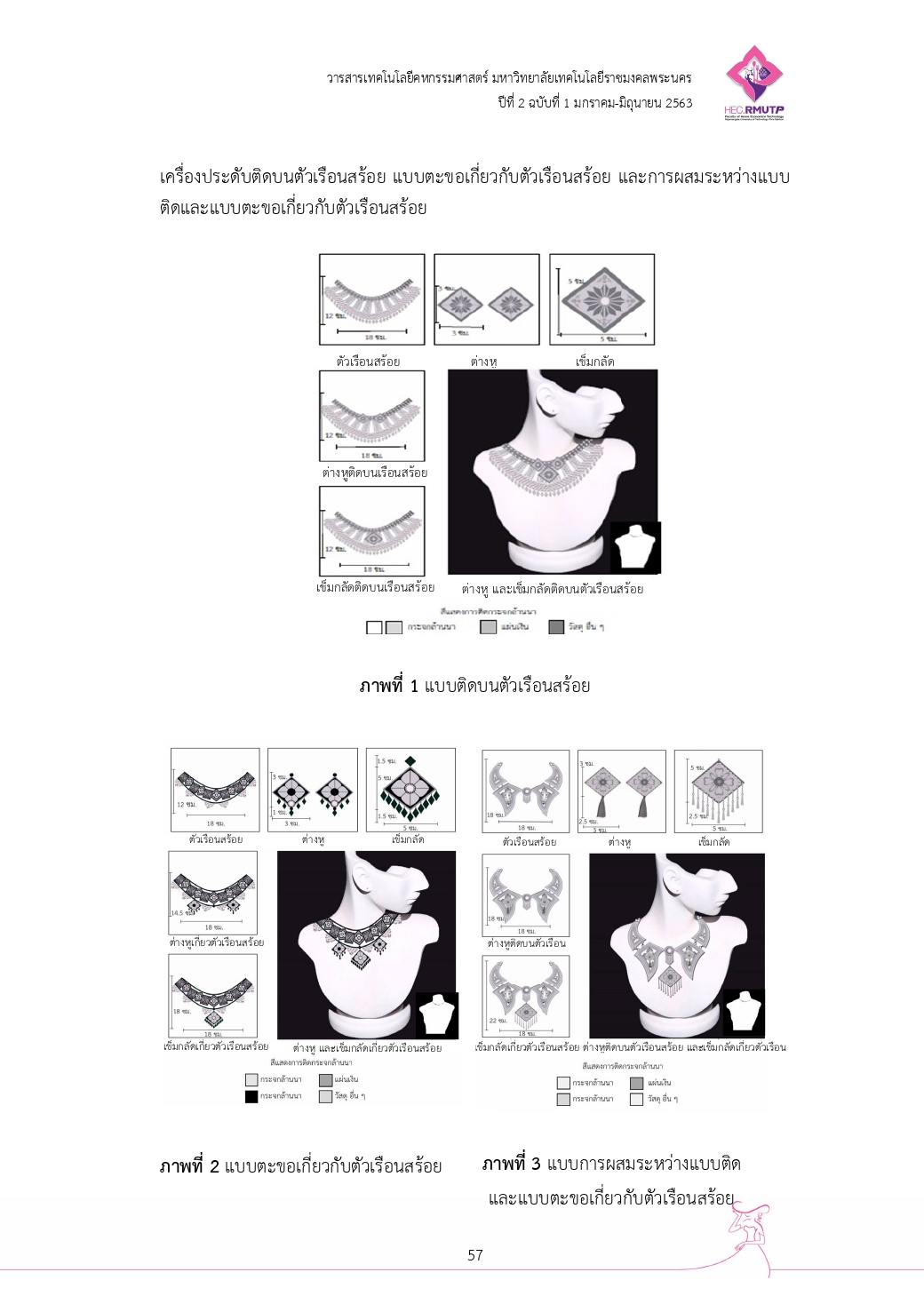The Creation of Transformative Jewellery for Women from Lanna-Style Glass
Main Article Content
Abstract
The purpose of this research is to study the process of creating transformative jewellery for women from Lanna-style glass. The essential data from related theories as well as recommendations from five experts were compiled. The satisfactions towards the product were also collected from two groups of people; 1) twenty-five jewellery entrepreneurs and 2) twenty-five working women aged 18-60 years. The total data of fifty samples were analysed. The results found that jewellery can be transformed by the combination of using studs and hooks. The transformation techniques inspired by Tai Lue jewellery; an old ethnic group adorning the body with unique silverware. In terms of the satisfaction on the style of the jewellery, the study showed, both groups were satisfied at the highest level although the mean of the former group is lower than the latter (the mean scores are 4.32 and 4.48 respectively). Likewise, both groups were satisfied with the materials at the highest level however the mean of the latter group is lower than the former (the mean scores are 4.34 and 4.32 respectively). In terms of utility, both groups had the satisfaction at a high level, with the mean of 4.05 and 4.17 respectively. Regarding the price, the entrepreneurs and working women were satisfied at a high level (3.96 and 3.98). For the place of distribution, the entrepreneurs were satisfied at a high level (4.16) while working women were satisfied with the highest level (4.43). The transformation techniques can make more spectacular jewellery. It is also the inheritance of the wisdom of making Lanna-style glass (Kaew Chuen), the monetization for the skilled craftsmen or Sala, and the conservation of the Lanna tradition in Thailand.
Article Details
References
กรมศิลปากร. 2559. กระจกตะกั่ว ศิลปะในสถาปัตยกรรมไทยภาคเหนือ กรณีศึกษาวิหารขนาดเล็ก จังหวัดลำปาง ลำพูน และเชียงใหม่. กรุงเทพฯ : พิมพ์ดี.
กฤษณา สุดสวย. 2555. ผลิตภัณฑ์ชุดเครื่องประดับจากย่านลิเภาด้วยเทคนิคมาคราเม่. ปริญญาตรี. สาขาวิชาการบริหารธุรกิจคหกรรมศาสตร์. คณะเทคโนโลยีคหกรรมศาสตร์. กรุงเทพฯ : มหาวิทยาลัยเทคโนโลยีราชมงคลพระนคร.
จุฑาภัทร คงสุนทร. 2552. ผลิตภัณฑ์บุษบกจำลองด้วยเทคนิคการทำเครื่องเขินล้านนา. ปริญญาตรี. สาขาวิชาการบริหารธุรกิจคหกรรมศาสตร์. คณะเทคโนโลยีคหกรรมศาสตร์. กรุงเทพฯ : มหาวิทยาลัยเทคโนโลยีราชมงคลพระนคร.
ณัฐวดี จันทร์โกมล และนิธิกร แว่นแก้ว. 2561. การประดิษฐ์เครื่องประดับจากเศษผ้าหม้อห้อม. ปริญญาตรี. สาขาวิชาการบริหารธุรกิจคหกรรมศาสตร์. คณะเทคโนโลยีคหกรรมศาสตร์. กรุงเทพฯ : มหาวิทยาลัยเทคโนโลยีราชมงคลพระนคร.
ณัฏศรา หมั่นเกตุ และจันทร์ธิมาพร นครสูงเนิน. 2561. การประดิษฐ์ชุดเครื่องประดับจากเปลือกกุ้งขาว. ปริญญาตรี. สาขาวิชาการบริหารธุรกิจคหกรรมศาสตร์. คณะเทคโนโลยีคหกรรมศาสตร์. กรุงเทพฯ : มหาวิทยาลัยเทคโนโลยีราชมงคลพระนคร.
รชต ชาญเชี่ยว. 2562. ผู้รื้อฟื้นภูมิปัญญาการทำแก้วจืน. สัมภาษณ์, 9 ตุลาคม 2562.
รสชง ศรีลิโก. 2552. “เครื่องประดับ,” สารานุกรมไทยสำหรับเยาวชน. เล่มที่ 34 : 113-143.
สยมภู ภวรุ่งสัตยา. 2555. การศึกษาเพื่อการออกแบบเครื่องประดับสตรีประเภทกำไลโดยใช้วัสดุประเภทพลาสติกเหลว. ปริญญาโท. สาขาวิชานวัตกรรมการออกแบบ. บัณฑิตวิทยาลัย. กรุงเทพฯ : มหาวิทยาลัยศรีนครินทรวิโรฒ.
สำนักงานการวิจัยแห่งชาติ. 2562. วช.ร่วมกับมหาวิทยาลัยเชียงใหม่ รื้อฟื้นการผลิตกระจกไทยโบราณด้วยวิจัยและนวัตกรรม. [ออนไลน์] เข้าถึงได้จาก : www.nrct.go.th/news/23 มีนาคม 2563.
สำนักโบราณคดี กรมศิลปากร. 2557. กระจกตะกั่ว : ศิลปะในสถาปัตยกรรมไทยภาคเหนือกรณีศึกษาวิหารขนาดเล็กในจังหวัดลำปาง ลำพูน และเชียงใหม่. กรุงเทพฯ : สำนักโบราณคดี กรมศิลปากร.

